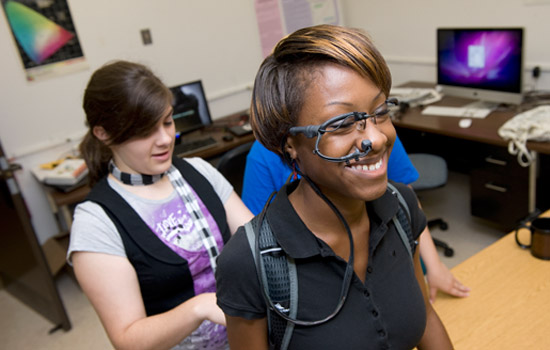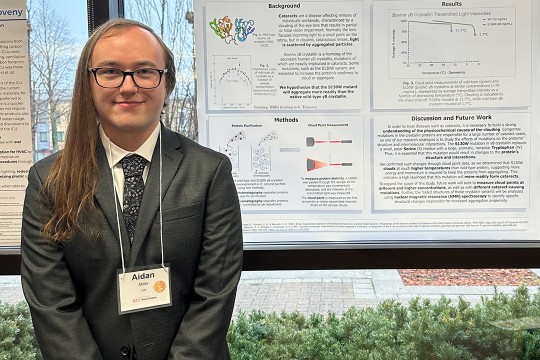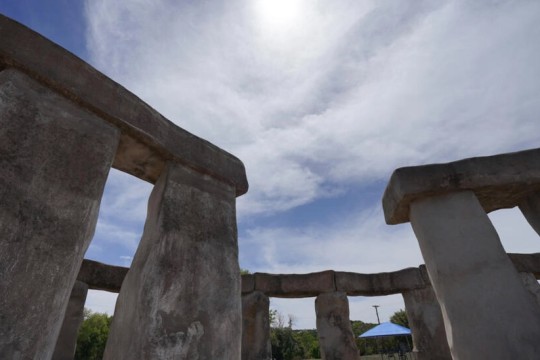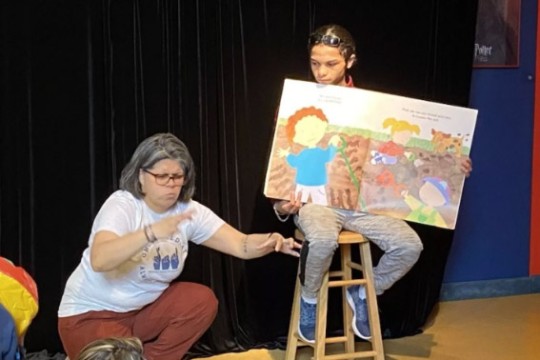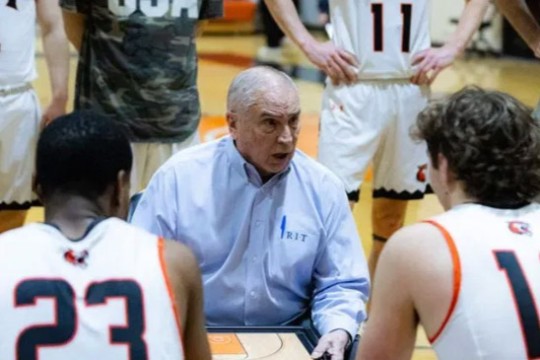Imaging science internship program gives high school students room to grow
A. Sue Weisler
Cicely DiPaulo, left, from Pittsford Mendon High School, adjusts the Positive Science Eyetracker worn by Octavia Rhim, from Benjamin Franklin High School. They spent the summer as interns in the Chester F. Carlson Center for Imaging Science, where they worked in the Multidisciplinary Vision Research Laboratory.
High school students Cicely DiPaulo and Octavia Rhim know the eyes have it, especially when it comes to video games. As part of their research agenda, the summer interns are taking a close look at how people play video games, comparing the beginners to the aficionados, by looking at the pattern of their eye movements.
In addition to working on projects sponsored by the National Science Foundation and Proctor and Gamble, Di Paulo and Rhim have designed their own research project on video game playing at the Multidisciplinary Vision Research Laboratory under the guidance of co-director Jeff Pelz. Throughout the summer, the two high school students have interacted with undergraduate and graduate students and faculty from the Center for Imaging Science, computer and information systems, computer engineering and psychology.
“Octavia and Cicely did a great job of leveraging the broad expertise around them,” says Pelz. “They designed the experiment, learned about the instrumentation and the tools they needed, the collected and analyzed their data.
“They sought out the expertise of those in the Multidisciplinary Vision Laboratory, such as computer engineering graduate student Piyush Agarwal, who is developing new eye-movement collection systems, and imaging science postdoctoral researcher Karen Evans, who helped them understand the necessary data analysis techniques.”
Di Paulo and Rhim were among the 16 high school juniors chosen for the Summer Internship Program run by the Chester F. Carlson Center for Imaging Science. The participating students represent 14 different high schools in the surrounding area.
The paid internship has given the students a chance to explore different aspects of imaging science, including diagnostic eye imaging, space weather, visual perception, remote sensing, astronomy, ultrasound imaging and magnetic resonance imaging.
The program will conclude with each group presenting its research results from 9 a.m. to noon this Friday in the Carlson Auditorium.
“This session is my favorite day of the year,” says Stefi Baum, director of the Center for Imaging Science. “Hearing the accomplishments and passions of these high school students is truly inspiring and reminds us what our students are capable of it given the opportunity to stretch themselves.”
“As a group, this year’s interns are by far the best we’ve ever had,” says Joe Pow, associate director of the Center for Imaging Science. “I have no doubt that they can handle the rigor they’d find in a degree program such as imaging science.”
Now in it its 11th year, the program began as a small outreach initiative developed as a way to connect with talented high school students. Since then, it has grown into its own entity, providing local high school students unique research experiences. Bob Callens, physics teacher at Honeoye Falls-Lima, joined Pow seven years ago as a Summer Program Coordinator and helps to manage the 10-week program.
“Being able to contribute to authentic research is an incredible opportunity for high school students,” says Callens. “It also gives them a feel for the academic challenges they can expect to encounter when they get to college.”
The application process for the 2011 Summer Internship Program will begin in January.











